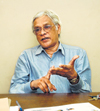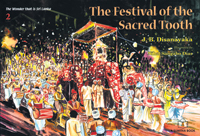| Rituals of the Kandy Perahera
It is one of those strange truths that one can be born in a country and live in it and yet not know much about it. Our traditions and customs make us what we are…they tell us where we come from, and yet many of us don't understand them at all.
Prof. J.B Disanayaka is determined to change that. A noted scholar, Prof. Disanayaka has made the study of Sri Lankan history one of his passions. He first became involved as a student of Dr. Senarat Paranavitana, who was the first Professor of Archaeology in the University of Ceylon, Peradeniya. (In those times, this was the only university around.) Dr. Paranavitana was mainly responsible for the restoration work at Mihintale. As a student of archaeology, Prof. Disanayaka himself was to take an active part in the excavations at the Citadel in Anuradhapura, under the guidance of Professor P.C. Sestieri, in September 1958. A year later he toured South India, visiting places of archaeological interest such as Mahabalipuram and Kancipuram. Later he would become a lecturer. He laughs as he explains that he never left university - first he was there to be taught, and then he stayed on to teach. He has been a teacher for 41 years now.
Today, Prof. Disanayaka's interests go far beyond that of buildings alone. For many years now, he has studied our traditions, customs, rituals, myths and legends. Not content with having learned this for himself, he has always enjoyed sharing his knowledge with others. In a series of books for children titled 'The Wonder that is Sri Lanka', Prof. Disanayaka, explains some of this islands most sacred festivals and rituals. It is written simply and clearly, so that everyone can understand, and yet details have not been left out. His most recent book is 'The Festival of the Sacred Tooth'. With beautiful illustration by the mute artist Nihal Sangabo Dias, this book is a wonderful addition to any child's library. It begins with a history of Kandy and follows through with descriptions and explanations of Sri Lanka's most famous procession - the Dalada Perahera. Prof. Disanayaka introduces a large cast of important characters. He begins with the Diyavadana Nilame, (the principal custodian of the sacred tooth relic) and ends with the actual participants in the Perahera itself. The slim book is filled with information, including the impact certain historical figures had in shaping the current tradition. King Vimaladharmasuriya I, King Kirti Sri Rajasingha and the Venerable Vaelivita Sarnankara all make their appearance. Places too are given due attention. The Temple of the Sacred Tooth in Kandy and Kandy itself are talked about. Prof. Disanayaka also describes the Water Cutting Ceremony and how Sri Lankans believe that it will always rain on that day. Prof. Disanayaka says he loves to write for children, especially as he has grandchildren of his own. He admires them for their innocence and creativity and says that they will do well to learn about their own culture. Enid Blyton stories might be entertaining but then again so are our Sri Lankan folktales. For instance, "Jack may have gone up to heaven by climbing a beanstalk but we have Gamarala who went up holding an elephant's tail," says Prof. Disanayaka.
| |||||
Copyright © 2006 Wijeya Newspapers
Ltd. All rights reserved. |

